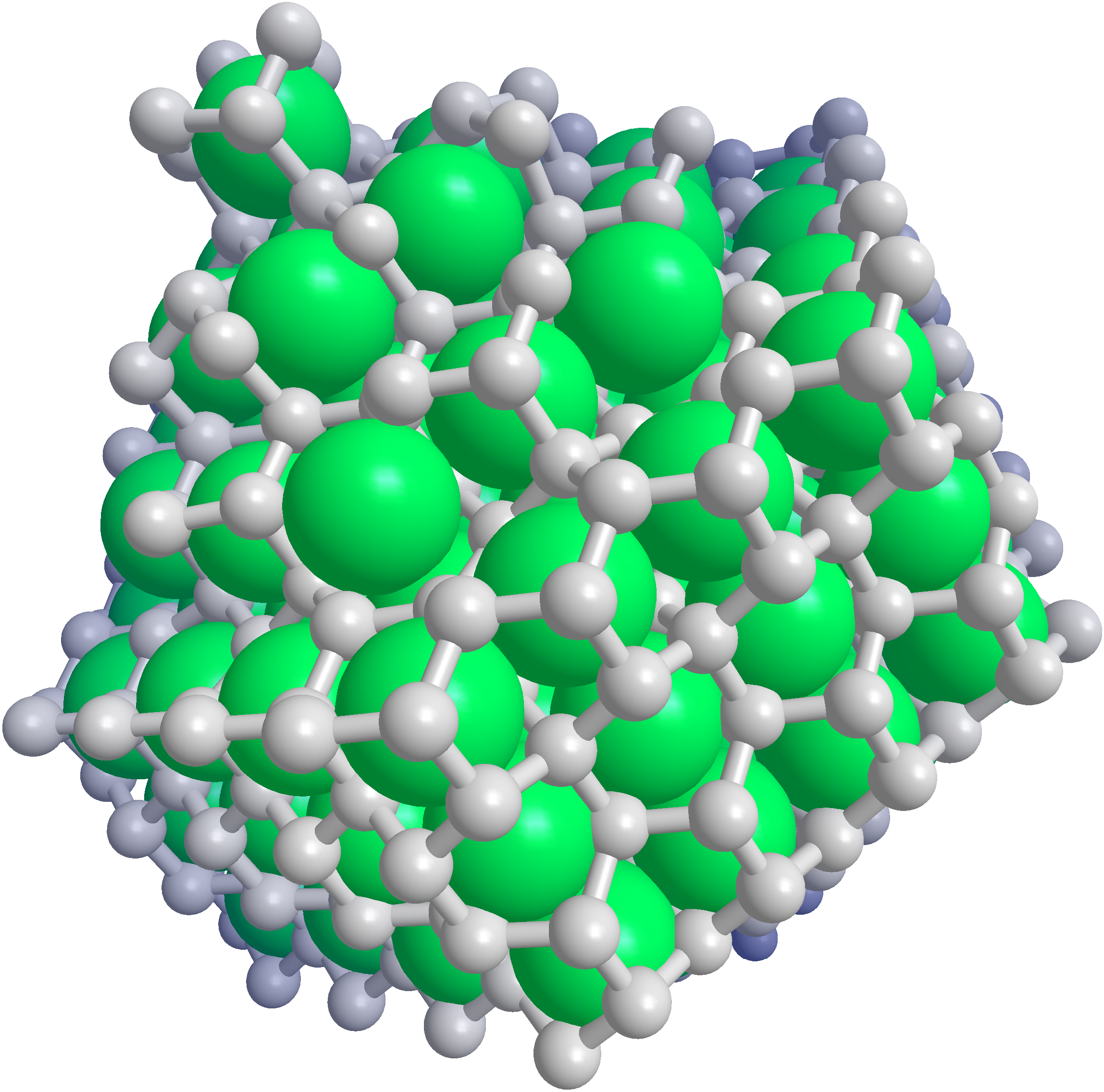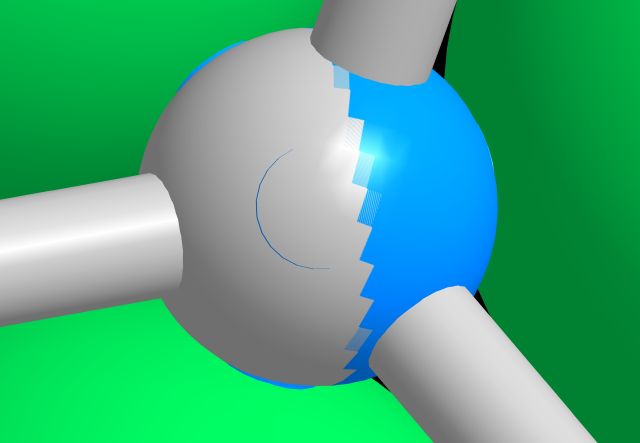
----------
10 m
ChemBio3D
 ----------
10 m
ChemBio3D |
| < A modular space colony > |
| A space station converting CO2 to O2 is built from carbon fiber tubes and spheres. All tube elements are identical to each other, and also all spherical elements. Up to 4 tubes can be connected to each sphere. A tube has a cross section diameter of 1 m, a sphere a diameter of 3 m. Each sphere is a potential habitat for one resident, and the tubes function as connectors and passage ways between the spheres. Sphere openings without tube are closed by doors. Doors are also at both ends of each tube. Each sphere has 4 circular windows (1 m diameter) opposite to the doors (not shown in the figure above). The station is entered at any of the outer spheres (in grey). |
| Into this lattice, big plastic balloons with photosynthetic organisms are inserted (in green). After inflation, each balloon is tightly contacted by up to 6 spheres (and by neighboring balloons). Each balloon is equipped with 6 potential openings matching the windows of the contacted spheres. At these points it is firmly attached to the lattice, and at least at 2 contacts atmosphere is allowed to pass freely between sphere and balloon. The atmosphere of the space station is constantly streaming through a chain of spheres and balloons. All balloons participate in this circulation, but not necessarily all spheres (depending on crew size). |
| The station is assembled in space by and by, combining increasing numbers of the 3 building components. The overall dimension depends on the productivity of the photosynthetic organisms and on crew size. In the example depicted above several hundred spheres and tubes have been assembled. The construction contains 165 balloons in 3 concentric layers. It remains to be seen, how many passengers can be supplied with oxygen by such an assembly. |
| In principle, the station can be extended into any direction without limitation. In the absence of gravity, the number of photosynthetic balloons could be increased until sufficient CO2 is reconverted to O2 to supply also larger crews. If damage occurs, e.g. from a smaller meteor, the damaged parts can easily be replaced by new components. The number of photosynthetic layers could be increased until all radiation is absorbed and the middle of the globular arrangement falls into darkness. Hopefully, by this also harmful radiation would be reduced. |
| The great number of spacious spheres (in grey) would allow the large-scale storage of provisions and water. To reduce the necessary amount of water, instruments for the processing of waste water may be installed in some of the spheres, like the one installed on the ISS in 2009 to recover and recycle moisture from the station's atmosphere, and urine. Also spare parts could be stored, as additional balloons to replace damaged or malfunctioning ones. It remains to be seen whether water managment really needs a complicated recycling machine. Alternatively, it may condensate and accumulate into humps in some of the colder districts of the station, where it could simply be collected with plastic bags. |
| Each balloon has a rich inner structure consisting of lamelles and flexible, fully transparent chambers, harboring colonies of photosynthetic organisms. Inflated, each of them has a diameter of about 8 m, but deflated they should fit through one of the 1 m windows of the spheres (to allow replacement). The organisms are that part of the tools kit that still is missing. They have to be fairly productive, but also resistant to extreme temperature and pressure changes as will occur during installation and routine use (see experiments at the DLR Institute of Planetary Research in Berlin). We may even succeed in breading photosynthetic organisms that thrive on high energy radiation (usually not available on Earth). Balloons may, however, also be equipped with soil and more conventional plants. |
| The
biologically active balloons are the most susceptible part of the
station, since they are protected only by an elastic transparent
envelope (however, Bigelow Aerospace demonstrate that inflatable habitats can be quite resistant). Small holes may be repaired within hours or days. However, a
catastrophic loss of pressure must result in the automatic closure of
all openings between the destroyed balloon and neighboring spheres, to
prevent excessive loss of atmosphere. Thus, such a balloon is a
dangerous place to stay, but nevertheless can be entered e.g. for
repair purposes or even for harvesting plant material. |
| A space shuttle vehicle, that allowed the crew to reach the station, will remain attached to the station and may be helpful for minor corrections of position or for the elimination of unwanted rotation (although the station may have its own propulsion equipment). Docking is possible at any of the doors of the outer spheres (grey). Once the destination planet is reached, the small vehicle will allow to reach its surface. In case of absence of passengers for some time, the photosynthetic organisms should be able to enter a state of reduced activity, returning to full activity only if CO2 supply rises again. |
| To avoid exposure of humans to unknown risks, a small version of a space cycler could complete a first cycle of a few years unmanned, simulating the presence of passengers by catalytic combustion or by setting free controlled amounts of CO2. Monitoring constantly the composition of the atmosphere should indicate the efficiency of the biological system. Preexperiments will also be conducted on Earth, but the long-term effect of the lack of gravity will only be apparent after a few years in space. Fortunately, we have no need to hurry. Preliminary data obtained with Arabidopsis grown on the ISS are encouraging (Paul et al 2012). |
| MB 6/13 |
| next: Lessons from Euclid back to: A garden in outer space? overview |
| Paul A-L, Amalfitano CE, Ferl RJ (2012) Plant growth strategies are remodeled by spaceflight. BMC Plant Biol 12:232 |
 |
Enlarged
view to one habitat sphere (3 m) surrounded by 3 photosynthetic
balloons (8 m). The circle in the centre indicates the position of a
window (1 m), that may serve as connection to a 4th balloon. |